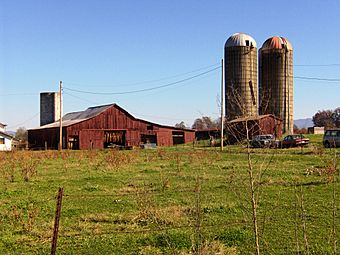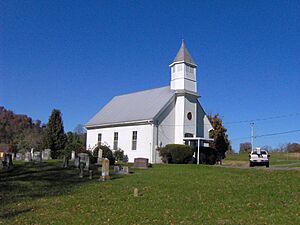Earnest Farms Historic District facts for kids
The Earnest Farms Historic District is a special historical area near Chuckey, Tennessee in Greene County, Tennessee. It includes four old farms and other important buildings. These farms are called Elmwood Farm, Broyles Farm, Crum Farm, and Jim Earnest Farm. They were first started by an early pioneer named Henry Earnest (1732–1809) and his family in the late 1700s and 1800s.
The district also has the Ebenezer Methodist Church. This church is home to the oldest Methodist group in Tennessee. Another important building is the Earnest Fort House, which is one of the oldest houses in the state. Elmwood Farm is known as a Century Farm, meaning it has been farmed continuously since 1777, making it one of Tennessee's oldest farms.
Henry Earnest settled by the Nolichucky River in 1774. He built the Earnest Fort House on a hill overlooking the river in 1782. Earnest gave the land for the Ebenezer Methodist Church. It was finished in 1795 and officially opened by Bishop Francis Asbury that same year. When Henry Earnest passed away in 1809, his land was divided among his children. His son Peter received what is now Elmwood Farm, and his son Henry Earnest, Jr. received what is now Broyles Farm.
Throughout the 1800s, the Earnest family ran their farms like small businesses. They sold much of what they grew to make money. In the early 1900s, the Broyles family bought the Henry Earnest, Jr. Farm. They later turned it into a dairy farm. The historic district has 43 buildings or sites that are important to its history.
Quick facts for kids |
|
|
Earnest Farms Historic District
|
|

Tobacco barn and silos at the Broyles Farm
|
|
| Location | Greene County, at Chuckey, Tennessee |
|---|---|
| Area | appx. 900 acres (360 ha) |
| Built | 1782–1951 |
| Architectural style | Federal, Bungalow, Italianate influence, I-house |
| MPS | Transformation of the Nolichucky Valley MPS |
| NRHP reference No. | 01001449 |
| Added to NRHP | January 11, 2002 |
Contents
Where are the Earnest Farms Located?
The Nolichucky River curves around the Earnest Farms Historic District. It forms the eastern, northern, and western edges of the district. The Earnest Fort House is just north of the river.
The Crum Farm is the furthest east. The Nolichucky River runs along its eastern and northern sides. The Broyles Farm is right next to the Crum Farm, to its west. Elmwood Farm is immediately west of the Broyles Farm. The Jim Earnest Farm is southwest of Elmwood. The river flows along the western edge of Elmwood and Jim Earnest farms. The southern edges of all four farms together make up the district's southern boundary.
Tennessee State Route 351 (also called Chuckey Pike) crosses Elmwood Farm. It runs from north to south. This road connects the area to the Chuckey community across the river. It also leads to the Cherokee National Forest to the south. Along the southern edge of Elmwood Farm, TN-351 goes up a 100-foot (30-meter) hill. From there, you can see a great view of the Bald Mountains in the distance. Davy Crockett Birthplace State Park is across the river from the Crum Farm. This park is believed to be where frontiersman Davy Crockett was born.
The History of Earnest Farms
Henry Earnest was born Heinrich Ernst in Dattlikon, Switzerland, in 1732. He moved to Virginia with his parents in the 1740s. After serving in the Virginia militia during the French and Indian War, he married Mary Stephens in the 1760s. Then, he moved southwest. By 1774, he had arrived in what is now Greene County.
The Earnest family supported the American side during the American Revolutionary War. Henry Earnest's son, Felix, fought in the Battle of Kings Mountain in 1780. The Earnests also helped create Greene County in 1783. Henry Earnest became the county's first tax assessor.
Henry Earnest built the Earnest Fort House in 1782. He turned the land around it into a successful farm. Around 1800, he started building the Henry and Peter Earnest House. This house was across the river from the fort house. When he passed away in 1809, his farm was divided. His son Peter (1777–1862) received what is now Elmwood. His son Henry, Jr. (1772–1851) received what is now the Broyles Farm. His son Felix (1762–1842) received what is now the Jim Earnest Farm.
Peter Earnest improved and made the house his father built bigger. Henry Earnest, Jr. built a similar house, now called the Earnest-Broyles House, around the same time.
Peter, Henry, Jr., and their brother Jacob were all listed as merchants in the early 1800s. Their names often appeared in the records of a general store in Leesburg. Felix Earnest was a minister and a leader in the Methodist Church. He became a deacon in 1806 and an Elder in 1825. Henry Earnest, Jr. represented Greene County in the state senate from 1811 to 1813. He also became a founding board member of Tusculum College when it started in 1818. When the East Tennessee and Georgia Railroad built tracks through Chuckey in the 1850s, Peter Earnest built a toll bridge. This bridge connected the Earnest farms to the railroad.
The Earnest farms survived the American Civil War mostly in good condition. However, the local economy was badly damaged. The toll bridge was replaced in 1869 and again in 1903. In the 1940s, the Broyles family, who owned the Henry Earnest, Jr. properties, started a large dairy farm. They did this mainly because a Pet Milk plant had opened in Greeneville. However, the dairy business eventually failed. Today, tobacco is the main crop grown on the Elmwood, Broyles, and Crum farms.
Ebenezer Methodist Church: A Historic Place of Worship
In the early 1790s, the Earnest family and other local families started a Methodist group. A Methodist circuit rider named Francis Asbury gave a sermon to 200 people at "Squire Earnest's" in 1793. He noted that a group of 31 members had formed. The Earnests later gave land for a meeting house. This land was between the river and the Jim Earnest Farm. On April 27, 1795, Asbury dedicated the new meeting house. This marked the beginning of the Ebenezer Methodist Church. The church building you see today was built on the same spot as the 1795 meeting house. It was finished in 1899.
The church is a one-story building made of wood. It has a metal roof that slopes down on two sides. The outside walls were originally made of wood planks, but now they have vinyl siding. The church has a two-story bell tower with openings for sound. It holds a bell bought from the Cincinnati Bell Foundry. Inside, you can still see the original wooden walls, hand-painted doors, and pews. There is also a beautiful stained glass window. The church's cemetery is also part of the historic district. Many Earnest family members and other church families are buried there.
Important Historic Buildings
Elmwood Farm: A Century of Farming
Elmwood Farm was part of the land Peter Earnest received from his father, Henry, in 1809. When Peter Earnest passed away in 1862, the farm went to his son, Benjamin. After Benjamin's death in 1887, it went to his son Nicholas Earnest. Nicholas Earnest managed Elmwood until he passed away in 1956. Then, the farm was divided among his six children. His daughter, Katherine Earnest Clemmer, bought her siblings' shares of the farm.
Elmwood is the only farm in the district that is still owned by Earnest family members. In 2002, it was named a Tennessee Century Farm. It is the second-oldest farm in the state. The farm has eleven important buildings, including:
- The Earnest Fort House, also known as the Mauris-Earnest Fort House. This is a three-story building finished in 1782 or 1783. The first floor walls are made of limestone blocks. The second and third floors are made of logs. This building was added to the National Register of Historic Places separately in 1978.
- The Henry and Peter Earnest House. This is a two-story brick house built in the Federal-style. It was started in the early 1800s and made bigger over time. Henry Earnest built the back part of the house around 1800. Peter Earnest added the Federal-style front in 1820. This created its "I-house" shape. He also added a smokehouse and other buildings. An open porch was added in the 1850s. A Colonial Revival-style porch was added in the 1920s.
- The Earnest Bridge Substructure. This is a stone support for a bridge. It stands in the middle of the river, west of the modern TN-351 bridge. It was built in 1903 using stones from the 1869 Earnest toll bridge.
- A two-story brick smokehouse. It is located west of the Henry and Peter Earnest House. It was built around 1820 to smoke meat. Later, it was used to store milk when the farm had dairy operations.
Broyles Farm: From Dairy to Tobacco
The Broyles Farm was originally part of the land Henry Earnest, Jr. received from his father in 1809. The Broyles family bought the farm in 1903. The farm has eighteen important buildings, including:
- The Earnest-Broyles House. This is a two-story brick Federal-style house. Henry Earnest, Jr. built it in 1820. The house has a porch influenced by Colonial Revival style. The inside has a Federal-style feel.
- A two-story wooden tobacco barn, built around 1940.
- A board-and-batten barn for livestock and tobacco, built around 1920. It was first for animals but is now used for tobacco.
- Three concrete silos. One was built in the 1940s, and two side-by-side were built in the 1950s. The oldest silo no longer has its dome roof. The two newer silos have dome metal roofs.
- A two-story concrete building. It was first used as a milk house for the farm's dairy business. Later, it became a house for workers.
Crum Farm: A 1920s Tobacco Farm
The Crum Farm is a tobacco farm that started in the 1920s. The Crum Farm has eight important buildings, including:
- The Crum Bungalow. This is a 1.5-story house built around 1920. It has a metal roof and a brick foundation.
- A board-and-batten chicken coop, built around 1930. Its design might have been inspired by plans from the University of Tennessee in the 1920s.
- A board-and-batten wood shop, built around 1920.
Jim Earnest Farmstead: A Family Legacy
The Jim Earnest Farmstead is part of the land Felix Earnest received from his father, Henry Earnest, in 1809. After Felix Earnest passed away in 1841, the farm went to his two sons, James Oliphant Earnest and William McKendrie Earnest. William's son, Jim Harvey Earnest, inherited the farm in 1902. He managed it until the 1930s. The farmstead has four important buildings:
- The Jim Earnest House. This is a three-story house built around 1880 in the Folk Victorian style. A part that sticks out in the front looks like Italianate tower designs. The house has wooden siding and an asphalt shingle roof.
- A one-story board-and-batten tobacco barn, built around 1920.
- A one-story house for workers, built around 1900. It had a metal roof added in the 1920s.
- A board-and-batten storage shed, built around 1920.
Images for kids














